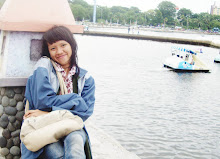skip to main |
skip to sidebar
Summer is the season for festivals large scale in Japan. Supported by good weather and a long weekend, this season became the season's most 'alive'. Tank top and shorts super-short was a favorite, knowing the heat. Night yukata (summer kimono) complete with uchiwa (fan) and geta (wooden sandals) is the appropriate dress to go to the festival (Natsu Matsuri) in the Temple.
This festival rang with merchants who lined the road, illuminated by hundreds chuochin (lanterns). The merchants sell a variety of toys, omen (mask), furin (klintingan), snacks like wataame (candy cotton) and kakigori (shaved ice) or foods such takayoki (octopus grilled), yakitori (chicken kebabs), Okonomiyaki (a type of martabak eggs filled at will we), yakitomorokoshi (roasted corn), etc.. Additionally, the festival also rang with a variety of traditional games. Among these, the most popular is kingyo sukui (catching goldfish). But summer tisak was complete without hanabi taikai (festival of fireworks).
Friends with Insects
This long holiday season the Japanese people used to hold a variety of interesting events. Most of the activities in direct contact with nature. Like for example, for the children, they would like to collect competed variety of insects. The sight of children carrying fishing nets and insect boxes, a typical part of summer in Japan.
"King" of insects in the summer is the favorite kabutomushi, or known in Indonesia with the title of coconut beetles. They competed in looking at the trees in the gardens around their homes, even some who deliberately go into the forest gang as a form of recreational activity groups. In addition to his own, shops pet toy stores also usually sell these insects. The price is relatively expensive, ranging between Y2.000 - Y10.000, or about Rp160.000-Rp800.000 perekor. Even some of the special type, the market price could reach about tens of millions of dollars. Kabutomushi from Indonesia, generally comes from Sumatra, Kalimantan and Sulawesi, is also quite popular and mainstream.
Japanese people used to play a power struggle between kabutomushi, as in Indonesia there cockfighting game. Form of the game like a sumo match. Made a circle as an arena to compete, and the two animals have raised dipertandingkan opponent to get out of the circle, or turn around your opponent plays back up to down, feet above. Which survive in the circle or stay in a standing position is perfect, that's the winner. Several television channels to make this event as their special show.
Kingyo Sukui
There is another unique event other colored thick enough summer in Japan. "Kingyo sukui", so to hear a familiar term. Kingyo means carp, sukui means levied or scoop. Held on the highway, which was already conditioned for this festival, such as installed various banners, lanterns, and food vendors and children's toys, from the traditional to the factory-made. Facility is a long-shaped pool, located right in the middle of the highway. Long pond filled with water and hundreds of small carp, there are also some other types of fish are also relatively small in size.
Fujisawa Kingyo Sukui in Ginza which was held in 2002, was recorded as kingyo sukui longest in the world. 100.8 meters long pool, with the number of participants around 60,000 people. This year, the same event in the same place, pool only 63 meters long, with the number of fish that included 45,000 head.
For those who want to try to catch fish, must buy a special pickup. Nets made of paper, which can be easily damaged when exposed to water. Usually Y200 unit price, or Rp16.000. In addition, cork is also given a bowl that could be a while if there are fish caught. With these two tools, participants can try to catch fish as much as possible, until the damaged nets because paper captors repeatedly dipped into the water.
Some participants seemed there was a smart and identify trends fish. He deliberately positioned above the water bowl, so that the fish gather below, such as seeking shade to hide from the open. Thus it is easy to catch a few fish as well.
Summer in Japan with all happiness soon ended. But the beauty of the leaves red and yellow in autumn was also interesting to enjoy.
Yukata
Yukata is a popular dress among the Japanese public at the beginning of the Edo period, about four hundred years ago, along with the popularity of cotton fabrics. In contrast to the kimono, yukata as used clothes after a hot bath, can be worn comfortably in the summer with no layers.
Today, almost everyone dressed in western style and a chance to wear Yukata little. But as a sign of the arrival of summer, many people are looking forward to wearing it at the time held the fireworks or summer festivals, etc..
Yukata worn by both men and women, as well as by adults and children alike, but especially when favored by young women.
Every year in June and July, many fashion magazines for young women who show a special edition of Yukata along with bathing suits. Also introduced in detail not only the image of traditional-style Yukata, Yukata but also with a new design complete with a good way to



0 komentar:
Posting Komentar